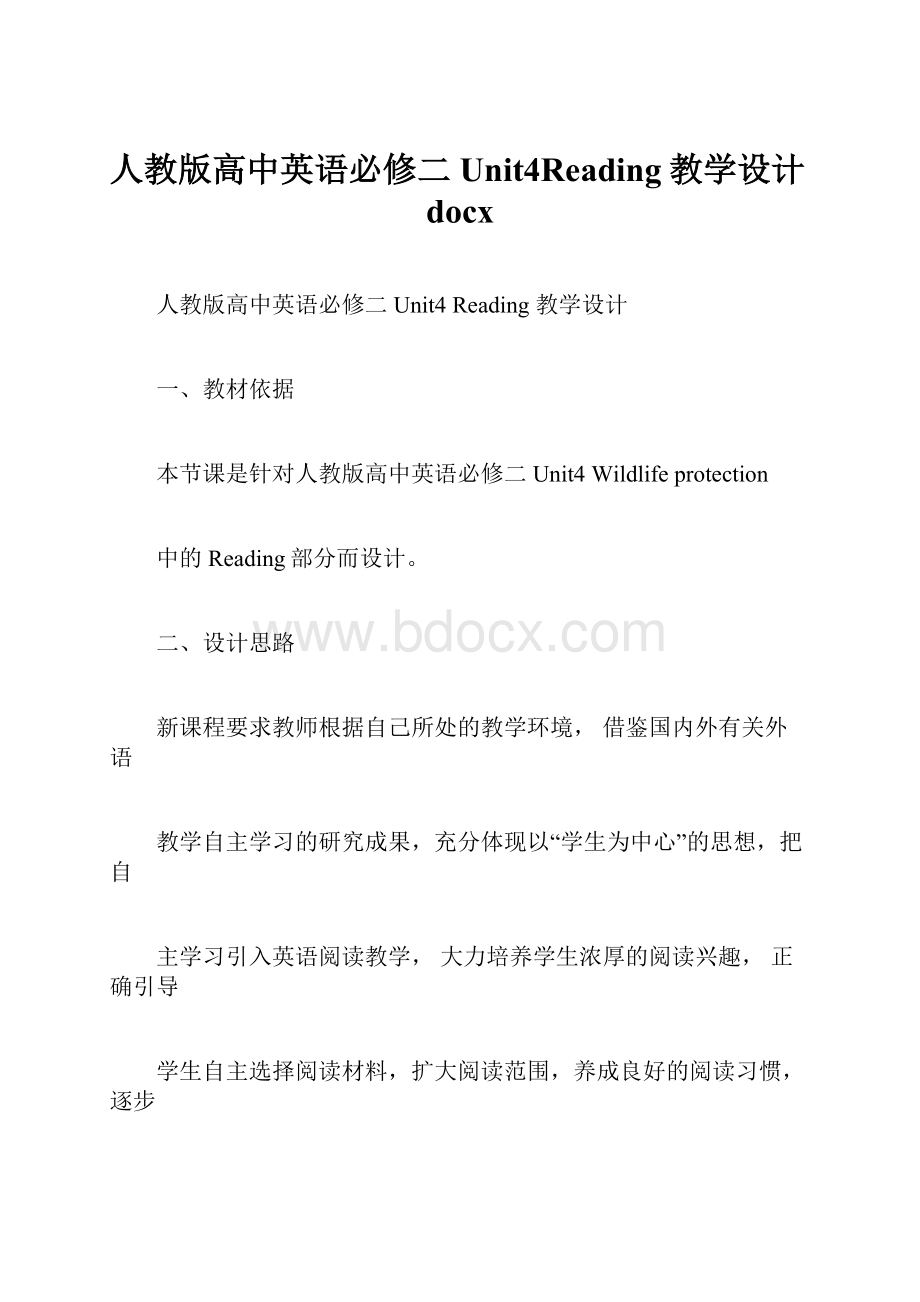人教版高中英语必修二Unit4Reading教学设计docx.docx
《人教版高中英语必修二Unit4Reading教学设计docx.docx》由会员分享,可在线阅读,更多相关《人教版高中英语必修二Unit4Reading教学设计docx.docx(25页珍藏版)》请在冰豆网上搜索。

人教版高中英语必修二Unit4Reading教学设计docx
人教版高中英语必修二Unit4Reading教学设计
一、教材依据
本节课是针对人教版高中英语必修二Unit4Wildlifeprotection
中的Reading部分而设计。
二、设计思路
新课程要求教师根据自己所处的教学环境,借鉴国内外有关外语
教学自主学习的研究成果,充分体现以“学生为中心”的思想,把自
主学习引入英语阅读教学,大力培养学生浓厚的阅读兴趣,正确引导
学生自主选择阅读材料,扩大阅读范围,养成良好的阅读习惯,逐步
掌握阅读技能,从而把学到的知识灵活运用到对语言、文章的理解中,
不断提高分析判断能力、逻辑思维能力和语言运用能力。
正是基于这
一指导思想,笔者把打造“学生自主阅读,实现有效教学”作为自己
的理念,设计了这堂阅读课。
本课围绕“野生动物保护”这一主题,通过描述Daisy在梦中经历一次奇妙的飞毯旅行,与藏羚羊、非洲象、猴子的对话,旨在让学生进一步意识到野生动物的生存环境日益恶化以及保护野生动物的
行动刻不容缓。
教学对象是高一学生,英语基础知识和基本技能都是一般水平,对英语学习兴趣不太浓。
因此,课堂教学活动设计主要以调动学生的学习兴趣、以学生的自主学习为目标。
三、教学目标
由于本节课是典型的阅读课,课文内容贴近生活并且时代感较
强,所以笔者在设计课堂教学目标时,在原有的要求学生理解文章意思、掌握细节信息的基础上,对情感价值观方面进行了一定升华,对学生深层面的能力提出了要求,具体如下:
知识与技能:
①通过图片和标题预测文章内容;运用略读和查读策略迅速获取信息。
②强化学生自主学习的意识,培养学生组织语言、运用语言的能力。
过程与方法:
①培养学生精读文章获取信息、分析信息的能力和独立阅读能力。
②通过自主和合作学习,培养学生理解信息和处理信息的能力。
情感价值观:
通过本节课的学习,让学生了解野生动物的处境和保护
野生动物的重要性;增强保护野生动物的意识。
现代教学手段运用:
让学生运用网络查询有关野生动物保护的途径和人与自然和谐相处的经典案例,学会将理论运用于实践,参与有关野生动物保护的活动。
四、教学重点
教学重点:
①对课文内容的整体把握;
②学生组织、运用语言的能力。
五、教学难点
教学难点:
①对课文内容中细节的理解;
②掌握概括文章大意和写文章摘要的方法。
六、教学准备
新课程提倡备课要既备教材、备学生、备教法,又备课标、备育
人、备资源,因此笔者在课前准备的时候,充分考虑到学生的需求和
水平,并根据自己的教学环境,对教材内容进行了调整和重组,删掉
了课后相对较难的问答题和表格填写,旨在让学生可以轻松、自如地
完成学习任务。
在设计课程的过程中,以学生的兴趣和情感为出发点,
以培养学生阅读以及语言运用能力为核心,始终突出“野生动物保护”
这一主题,设置难度较小的问答题、选择题、填空题和小组讨论等学
生有话可说的活动,充分体现阅读课“读”的特点,让每一个学生都
能够参与到课堂活动中来。
为了保证课堂教学的顺利进行,笔者尝试
了“学案式教学”,即把课堂要处理的阅读习题和探究式话题以“学
案”的形式提前呈现给学生,让学生利用此“先行组织者”在课前做
好预习、查找资料并做好活动准备。
另外,在多媒体课件的制作方面,
笔者力求简洁明了、层次分明,并适当运用丰富多彩的图片激发学生
的学习兴趣。
七、教学过程
Step1:
Revision
ReviewthewordsandexpressionsthatappearinthereadingpassagebyspeakingoutthemaccordingtotheirChinesemeanings.
carpetn.地毯respondvi.回答;做出反应
distantadj.远的;远处的furn.毛皮;毛;软毛
reliefn.(痛苦或忧虑的)减轻或解除;减轻痛苦的事物
mercyn.仁慈;宽恕;怜悯certainadj.确定的;某一;一定
importancen.重要(性)
affectvt.影响;感;侵
insectn.昆虫
appreciatevt.;感激;意到
mosquiton.蚊子
attentionn.注意;关注;注意力
containvt.包含;容忍
powerfuladj.大的;有力的
rubvt.擦;摩擦
succeedvi.成功vt.接替;任
incomen.
收入
secureadj.安全的;可靠的
employvt.
雇用;利用
harmn.vt.害;危害
inrelief如重;松了口气
payattentionto注意
burstintolaughter突然笑起来;大声笑出来
protectfrom保⋯⋯不受⋯⋯(危害)
明:
通件展示文中重点和短的意思,学生
出的英,鼓励学生充分参与到堂活中来,一方面正英
音,另一方面也做了身与准。
Step2:
Leading-in
Askstudentstolookatthetitleandtwopicturesonpage26andpredictwhatthetextisabout.Studentscanusetheirimaginationtotalkfreely.
明:
通看,直地将本内容用片展出来,合
上一已取的有关野生物保的信息,学生表自己的
解,以种方法入,引起学生的探究,培养学生察
和运用言交的能力,充分了他的极性和造性。
Step3:
Fastreadingforgeneralideas
Raisethequestiontoarousestudents’thoughts.
Q:
What’shistpassageabout?
Thenaskstudentstogothroughthetextquicklytofindouttheanswerstothefollowingthreequestions:
1.WheredidDaisygo?
Tibet,Zimbabweandrainforest.
2.Whotookherthere?
Aflyingcarpet.
3.Whatkindofanimaldidshemeetineachplace?
Anantelope,anelephantandamonkey.
Later,tellthemthewayofsummingupthemainideaofastory(Who?
Whathappened?
What’sthemeaningofthestory?
)accordingtotheabovequestionssothatstudentscansummarizeitsmainideabyfillingseveralblanksofasentence.
Daisytook(aflyingcarpet)totravelandtalkedwith(someanimals),whichmadeherknow(theimportance)ofthewildlifeprotection.
设计说明:
通过略读文章回答问题和填写相关空格,学生能够快速掌
握文章大意,也学会了概括文章大意的方法,同时以填空的方式完成
任务,也降低了难度,学生能轻松学习,不至于因太过复杂而丧失兴
趣。
Step4:
Structure
Letstudentsfindoutthestructureofthepassagebyfindingrelatedparagraphsaccordingtosomepicturesofthetextandmatchthemwiththeirownmainideas.
Daisy
antelopeelephantmonkey
Which
paragraph:
para1para2paras3--4
Where:
Tibet→Zimbabwe→rainforest
Mainidea:
Whatwecangetfrompara1
wildlifeprotection.
Whyweneedwildlifepara2
protection.
Agoodexampleof
wildlifeprotectionparas3--4
设计说明:
运用课件展示Daisy的旅游路线以及见到的相应动物,
让学生掌握文章结构,把握段落大意,为接下来的查读和精读任务打
好基础。
Step5:
Scanningtoanswerquestions
Askstudentstolistenandreadthepassagewiththefollowing
questionsintheirmindsothattheycananswerthem:
1.Howdidtheantelopefeel?
Theantelopefeltsad.
2.WhyarepeoplehuntingandkillingtheTibetanantelope?
Forthewoolbeneaththeirstomachs.
3.Whydidfarmershuntelephants?
Becausetheysaidelephantsdestroyedtheirfarmsandmoneyfromtouristsonlywenttothelargetourcompanies.
4.WhyareelephantnumbersincreasinginZimbabwe?
Thegovernmenthelpsthefarmers.Itmakessurethatthe
tourcompaniespaythefarmerswhentouristscometovisit
andhuntafewanimals.Thefarmersstopkillingtheelephants,sothenumbersareincreasing.
5.Whydidthemonkeyrubitself?
Becauseitwantedtofindamillipedeinsect.Itcontainsapowerfuldrugwhichaffectsmosquitoes.
6.Whyisitimportanttoprotecttherainforest?
Becausenorainforest,noanimals,nodrugs.
设计说明:
让学生充分发挥主观能动性参与课堂活动,利用小组讨论
和个人发言的方式完成阅读任务。
这样,既让学生大胆地开口说英语,
进行了口语表达,又培养了学生自主学习的能力,调动了他们学习英
语的兴趣,体现了“以学生为本”的教学理念。
Step6:
Detailedreading
Showsomemultiplechoicestoletstudentsreadthepassagecarefullyandchoosethebestanswer.
1.Paragraph1suggeststhat______.(A)
A.ThenumberoftheantelopesinTibetisgettingmuchsmallernow
B.Daisywouldliketoseetheantelopesverymuch
C.Theantelopeshaveallbeenkilledforthewoolandnone
wereleft.
D.TheantelopeshavemovedfromTibettosomeotherplaces
2.Whatcanbeinferredfromtheelephant’swords,
cometotakemyphoto(D)”?
“Have
C.Moneyfromtouristswenttothelargetourcompanies.
D.Nowmanymoretouristscometotakeitsphotosratherthanhuntit.
3.Fromtheendofthestorywecanconcludethat______.(D)
A.TheWWFwillhelpDaisytomakethepowerfuldrug.
B.TheWWFhasdonelittletoprotectwildlife.
C.PeoplewillstopkillinganimalswiththehelpoftheWWF.D.Daisywillcontinuetohelpprotectwildlifebyworkingwith
theWWF.
4.WhatdidDaisylearnfromherexperience?
(D)
A.Someanimalswerebecomingendangeredasaresultofhumans’hunting.
B.Wildlifeshouldbehelpedandprotectedbyushumans.
C.Humansandwildlifecanbenefiteachotherinmanyways.
D.Alloftheabove.
设计说明:
给学生留出充足的时间让其自主探究找出问题的答案,并
讲明原因,以此来使学生踊跃参加活动,活跃了课堂气氛,充分调动
学生的学习积极性、自主性、合作性。
Step7:
TrueorFalse
Showthefollowingsentencestoletstudentsanalyzewhether
theyareTrueorFalse.
1.Daisywokeupandfoundaflyingshipbyherbed.F
2.DaisysawmanyantelopesinTibet.F
3.Daisy’ssweaterwasmadeofsheepwool.F
4.TheelephantusedtobewellprotectedinZimbabwe.F
5.ThefarmersinZimbabwegetnothingfromtelephantsnow.F
6.ThesecondanimalDaisymetwasanexcitedelephant.T
7.Asaresult,elephantswillnolongerbehunt.F
8.
Themonkeyrubbedtoprotectitselffrommosquitoes.T
9.
WWFmeanstheWorldWildlifeFund.T
设计说明:
让学生在读过每个句子之后判断其正误,巩固他们对课文
内容的理解,这也是上一个活动的延伸。
由于这些句子浅显易懂,学
生可以很容易地完成任务,从而增强了他们的成就感和自信心。
Step8:
Retelling
Letstudentsfinishoffashortpassagebyfillinginsomekey
wordssothatstudentscanretell
thewholepassagebyusing
theirownwords.
OnedayDaisywenttoseetheanimalsthatgavefur
to
makehersweaterinaflyingcarpet.ItflewawaytoTibet
in
Chinafirst,whereshesawanantelope.Theantelopetold
her
thattheywerebeingkilledforthe
woolbeneaththeirstomachs.
ThentheflyingcarpetflewawaytoZimbabwe,whereDaisy
sawanelephant.Theelephantsaidtheyusedtobean
endangeredspecies.Farmersusedtohuntthemwithoutmercy.Butwiththehelpofthegovernment,nowthefarmersarehappyandtheirnumbersareincreasing.
Thentheflyingcarpetroseagainandalmostatoncethey
wereinathickrainforest.Amonkeywasrubbingamillipedeinsectwhichcontainsapowerfuldrugoverhisbodybecauseit
couldprotecthimfrommosquitoes.SoDaisydecidedtoproducethisnewdrugwiththehelpofWWF.Thecarpetroseandflewhome.Althoughfinallyeverythingwasgone,shehad
learnedsomuch.
设计说明:
用启发的方式让学生在完成填空题后,鼓励个别学生用自
己的话复述课文,加深对文章的进一步理解,同时又锻炼了学生运用
语言的能力。
Step9:
Conclusion
MakeaconclusionabouthowDaisylearnedtohelpwildlifeandwhatshelearnedbydiscussingandsentence-makingactivities.Q:
WhatthingshadDaisylearned?
1)Shelearnedthatsomewildanimalswerebeingkilledorhunted.Andtheywereendangeredspecies.
2)Sheknewhowtheanimalsintherainforestlivedtogether.
3)Shealsolearneditwasnecessarytoprotectthewildanimals.
※Conclusion
Liveinharmonywiththewildlife!
EnjoyOurLife!
设计说明:
最后对课文作总结,通过短暂讨论和完成造句的活动,使
学生进一步了解野生动物保护的重要性,树立人与自然和谐相处的意
识。
这样可以把课文主旨和现实生活紧密联系起来,使学生的认识得
以提升,突出本课的最终目的。
Step10:
Homework
Chooseonestoryfromthereadingpassageandretellit.Youcanaddyourownideaswhileretellingyournewstory.Blackboarddesign(板书设计)
Module2Unit4Reading
HowDaisyLearnedtoHelpWildlife?
Step1:
Revision
Step2:
Leading-in
Step3:
Reading
Daisy
antelopeelephantmonkey
Which
paragraph:
para1para2paras3--4
Where:
Tibet→Zimbabwe→rainforest
Mainidea:
Whatwecan
Whyweneed
A
good
getfrom
wildlife
exampleof
wildlife
protection.
wildlife
protection.
protection
Step4:
Conclusion
Liveinharmonywiththewildlife!
EnjoyOurLife!
Step5:
Homework
八、教学反思
本节课是笔者的一堂公开课,充分发挥了多媒体教学课件的优势,使课堂的内容更加充实,容量更多。
既贯通了所要学的知识,又强化了人文素养,让学生在学习过程中兴趣更加浓厚,积极地自主探究